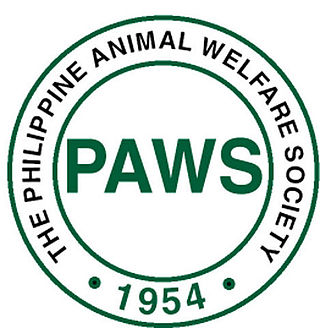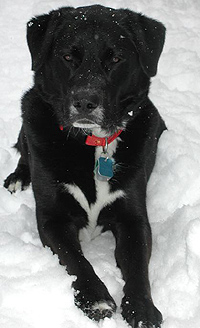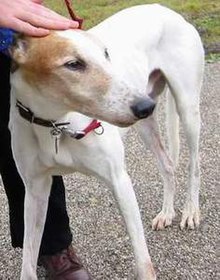
The EnglishGreyhound, or simply the Greyhound, is a breed of dog, a sighthound which has been bred for coursing, greyhound racing and hunting. Since the rise in large-scale adoption of retired racing Greyhounds, the breed has seen a resurgence in popularity as a family pet.

The whippet is a British breed of medium-sized dog, of the sighthound type, related to the larger greyhound and the smaller Italian greyhound. Apart from the differences in height, the whippet closely resembles these two breeds; it has sometimes been described as "the poor man's greyhound". It is kept as a companion dog, for competitive showing, for amateur racing as well as lure coursing. It has the highest running-speed of any breed in its weight and size range, and may have the fastest idle-to-running acceleration of any dog.

Greyhound racing is an organized, competitive sport in which greyhounds are raced around a track. There are two forms of greyhound racing, track racing and coursing; the latter is now banned in most countries. Track racing uses an artificial lure that travels ahead of the greyhounds on a rail until the greyhounds cross the finish line. As with horse racing, greyhound races often allow the public to bet on the outcome.
The American Society for the Prevention of Cruelty to Animals (ASPCA) is a non-profit organization dedicated to preventing animal cruelty. Based in New York City since its inception in 1866, the organization's mission is "to provide effective means for the prevention of cruelty to animals throughout the United States."

Pet adoption is the process of transferring responsibility for a pet that was previously owned by another party. Common sources for adoptable pets are animal shelters, rescue groups, or other pet owners. Some organizations give adopters ownership of the pet, while others use a guardianship model wherein the organization retains some control over the animal's future use or care.

An animal shelter or pound is a place where stray, lost, abandoned or surrendered animals – mostly dogs and cats – are housed. The word "pound" has its origins in the animal pounds of agricultural communities, where stray livestock would be penned or impounded until they were claimed by their owners.

A lurcher is a crossbred dog resulting from mating a greyhound or other sighthound with a dog of another type such as a herding dog or a terrier. The lurcher is not a "breed," but is a generic descriptor of a group of varying dogs. It was for hundreds of years strongly associated with poaching; in modern times, it is kept as a hunting dog or companion dog.
An animal rescue group or animal rescue organization is a group dedicated to pet adoption. These groups take abandoned, abused, or stray pets and attempt to find suitable homes for them. Many rescue groups are created by and run by volunteers, who take animals into their homes and care for them—including training, playing, handling medical issues, and solving behavior problems—until a suitable permanent home can be found.

Canine influenza is influenza occurring in canine animals. Canine influenza is caused by varieties of influenzavirus A, such as equine influenza virus H3N8, which was discovered to cause disease in canines in 2004. Because of the lack of previous exposure to this virus, dogs have no natural immunity to it. Therefore, the disease is rapidly transmitted between individual dogs. Canine influenza may be endemic in some regional dog populations of the United States. It is a disease with a high morbidity but a low incidence of death.
Dognapping is the crime of taking a dog from its owner. The word is derived from the term kidnapping.

Greyhound racing is a sport in the United Kingdom. The industry uses a parimutuel betting tote system with on-course and off-course betting available. Attendances have declined in recent years, mainly due to the decrease in evening fixtures with the majority of fixtures being held in the daytime.

The Philippine Animal Welfare Society (PAWS) is a volunteer-based, non-government organization whose goal is to prevent animal cruelty through education, animal sheltering and advocacy, based in Quezon City, Philippines. It was founded in 1954 by Muriel Jay. PAWS believes that the creation of a more peaceful society starts with the widening of mankind's circle of compassion which includes animals, thereby envisions a nation that respects animals, practices responsible pet ownership and protects wildlife. The volunteer-based organization rehabilitates these animals in the hope of finding them new homes and a second chance at a good life. PAWS does not take in pets of other people, but only victims of cruelty or neglect where the animal offenders are charged with violation of the Animal Welfare Act in court.

Black dog syndrome or big black dog syndrome is a phenomenon in which black dogs are passed over for adoption in favor of lighter-colored animals. Black cats are similarly reported to be subject to the same phenomenon.
The National Greyhound Association (NGA) is the primary registry body for racing purebred Greyhounds in the United States. Its main purposes is to provide humane advocacy, welfare policy and support to the adoption network. The association serves to provide policy and maintain standards of care to preserve the greyhound breed and bloodlines, and is located on Old 40 Highway in Abilene, Kansas, near the Greyhound Racing Hall of Fame.
The Greyhound Board of Great Britain (GBGB) is the organisation that governs licensed greyhound racing in Great Britain. It does not govern independent tracks or Northern Irish tracks and therefore has no jurisdiction over them.
Limerick Greyhound Stadium is a greyhound racing track located in south-west Limerick in Ireland.

Greyhound racing in Australia is a sport and gambling activity. Australia is one of several countries with a greyhound racing industry. The industry laws are governed by the State Government but the keeping of greyhounds is governed by the Local Authority.

The 1926 UK & Ireland Greyhound Racing Year was the inaugural year of 'track' greyhound racing in the United Kingdom and Ireland.
Greyhound racing in the United States is a sport and parimutuel gambling activity. The industry is regulated by state law and greyhound care is regulated by the American Greyhound Council (AGC) and the National Greyhound Association.
The 2022 UK & Ireland Greyhound Racing Year was the 97th year of greyhound racing in the United Kingdom and Ireland.












